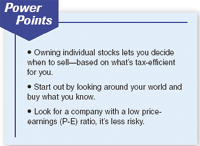Article
Investment Basics: How and why to buy stocks
Want to buy stocks but feel intimidated by Wall Street? Relax. Here's what you need to know to start making money.
At this point, you probably own mutual funds and real estate. Maybe you've picked up some bonds and Treasuries, too. (This and other italicized financial terms are defined in the glossary at the end of this article). But so far, no stocks. Perhaps you've developed the itch to play the market, but you don't know how to choose among thousands of companies in scores of industries. You can choose stocks from big, small, or medium companies or base your purchase on whether the stock's expensive or cheap. But how do you choose a winner? How should you buy it? Once it's in your portfolio, then what?
We answer these questions for you, so read on-and see why not investing in equities could be risky business.
Why you should own stocks

Yes, there have been market crashes and years when stocks remained flat. But $10,000 invested in 1925 in stocks of big companies would have been worth $488,100 by the end of 2005, after taxes and inflation. That's an average annualized return of 5 percent, notes Ibbotson Associates, a Chicago consulting firm that tracks investment performance. The same size investment in US government bonds would have grown to only $14,100-or 0.4 percent per year. And $10,000 hidden in a mattress in 1925 would be worth only $5,500 after inflation was done chipping away at it. That's an average loss of 0.7 percent annually.
But doing the research necessary to purchase stocks is hard work. Many investors like to hand off these tasks to an experienced professional manager, which is why mutual funds have become so popular. However, there are advantages to owning individual stocks. For one thing, you have control: You decide how much to buy, what to buy, and when to buy and sell. In addition, if you manage your own portfolio, you'll save the fee that mutual fund companies charge every year: around 1.35 percent of assets, whether your fund is up or down.
Another advantage is tax efficiency. If you sell a stock you've held for one year or less, any gain is taxed as a short-term capital gain and treated as ordinary income. If you've held the stock for longer than one year, the gains are taxed at the more favorable long-term capital gains rate of 15 percent. When you own individual stocks, you decide when to sell. When you own stocks through a mutual fund, it's the manager of the fund who decides when to sell, and he may have to weigh several other goals besides tax-efficiency in making a decision. That could result in a higher tax bill for you.
Still, given individual stocks' greater volatility, it makes sense to limit your overall investment. Says financial planner Kathleen Kee, "Only invest an amount that you can afford to lose."
How to build a stock portfolio
An investment of $5,000 or $10,000 is enough to let you put a toe in the water. Of course, you need to diversify to shield yourself from a big loss. In order to get this diversification, financial planner Robert W. Phelps recommends that new stock investors spread their risk by purchasing at least 15 different stocks from among the major economic sectors-one or two per sector. According to Phelps, the sectors are: basic materials (such as chemicals), capital goods (equipment and machinery); communications services; consumer staples (think toothpaste and detergent); consumer cyclicals, such as autos and furniture; energy; financial services; healthcare; technology; transportation; and utilities.





